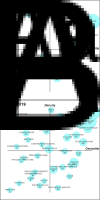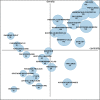30 years of parasitology research analysed by text mining
- PMID: 32867863
- PMCID: PMC10317710
- DOI: 10.1017/S0031182020001596
30 years of parasitology research analysed by text mining
Abstract
Bibliometric methods were used to analyse the major research trends, themes and topics over the last 30 years in the parasitology discipline. The tools used were SciMAT, VOSviewer and SWIFT-Review in conjunction with the parasitology literature contained in the MEDLINE, Web of Science, Scopus and Dimensions databases. The analyses show that the major research themes are dynamic and continually changing with time, although some themes identified based on keywords such as malaria, nematode, epidemiology and phylogeny are consistently referenced over time. We note the major impact of countries like Brazil has had on the literature of parasitology research. The increase in recent times of research productivity on 'antiparasitics' is discussed, as well as the change in emphasis on different antiparasitic drugs and insecticides over time. In summary, innovation in parasitology is global, extensive, multidisciplinary, constantly evolving and closely aligned with the availability of technology.
Keywords: Bibliometric analyses; database; parasitology; publishing; science mapping analysis; topic models; trends.
Figures






Similar articles
-
Using Data Mining, Text Mining, and Bibliometric Techniques to the Research Trends and Gaps in the Field of Language and Linguistics.J Psycholinguist Res. 2023 Apr;52(2):607-630. doi: 10.1007/s10936-022-09911-6. Epub 2022 Sep 20. J Psycholinguist Res. 2023. PMID: 36125692
-
Bibliometric analysis of parasite vaccine research from 1990 to 2019.Vaccine. 2023 Oct 20;41(44):6468-6477. doi: 10.1016/j.vaccine.2023.09.035. Epub 2023 Sep 28. Vaccine. 2023. PMID: 37777454 Review.
-
Implications of findings of bibliometric analyses in parasitology.Trends Parasitol. 2007 Jan;23(1):12-3. doi: 10.1016/j.pt.2006.10.004. Epub 2006 Nov 16. Trends Parasitol. 2007. PMID: 17112782 No abstract available.
-
Bibliometric analysis of core competencies associated nursing management publications.J Nurs Manag. 2022 Oct;30(7):2869-2880. doi: 10.1111/jonm.13795. Epub 2022 Sep 20. J Nurs Manag. 2022. PMID: 36076321 Review.
-
A Bibliometric Mapping Study of the Literature on Oral Health-related Quality of Life.J Evid Based Dent Pract. 2023 Jan;23(1S):101780. doi: 10.1016/j.jebdp.2022.101780. Epub 2022 Sep 14. J Evid Based Dent Pract. 2023. PMID: 36707159
Cited by
-
Scientific literature on neglected tropical diseases: a bibliometric analysis.Pathog Glob Health. 2024 Mar;118(2):91-98. doi: 10.1080/20477724.2023.2250619. Epub 2023 Aug 22. Pathog Glob Health. 2024. PMID: 37606248 Free PMC article.
-
Trends in Nanoparticles for Leishmania Treatment: A Bibliometric and Network Analysis.Diseases. 2023 Oct 28;11(4):153. doi: 10.3390/diseases11040153. Diseases. 2023. PMID: 37987264 Free PMC article. Review.
-
A Bibliometric Analysis and Global Trends in Fascioliasis Research: A Neglected Tropical Disease.Animals (Basel). 2021 Nov 26;11(12):3385. doi: 10.3390/ani11123385. Animals (Basel). 2021. PMID: 34944162 Free PMC article.
-
What's so special about special issues: Highlighting a central role of parasitology to support specific innovations and advance progress within our discipline.Parasitology. 2025 Jan;152(1):1-5. doi: 10.1017/S0031182025000125. Parasitology. 2025. PMID: 40223707 Free PMC article. No abstract available.
-
Bibliometric analysis of neutrophil extracellular traps induced by protozoan and helminth parasites (2008-2024).Front Immunol. 2025 Jan 24;16:1498453. doi: 10.3389/fimmu.2025.1498453. eCollection 2025. Front Immunol. 2025. PMID: 39925815 Free PMC article.
References
-
- Alvarez-Pellitero P (2008) Fish immunity and parasite infections: from innate immunity to immunoprophylactic prospects. Veterinary Immunology and Immunopathology 126, 171–198. - PubMed
-
- Barral A, Pedral-Sampaio D, Grimaldi Jr, G, Momen H, McMahon-Pratt D, Ribeiro De Jesus A, Almeida R, Badaro R, Barral-Netto M, Carvalho EM and Johnson Jr, WD (1991) Leishmaniasis in Bahia, Brazil: evidence that Leishmania amazonensis produces a wide spectrum of clinical disease. American Journal of Tropical Medicine and Hygiene 44, 536–546. - PubMed
-
- Batista FA, Gyau B, Vilacha JF, Bosch SS, Lunev S, Wrenger C and Groves MR (2020) New directions in antimalarial target validation. Expert Opinion on Drug Discovery 15, 189–202. - PubMed
-
- Baumann N (2016) How to use the medical subject headings (MeSH). International Journal of Clinical Practice 70, 171–174. - PubMed
Publication types
MeSH terms
LinkOut - more resources
Full Text Sources

